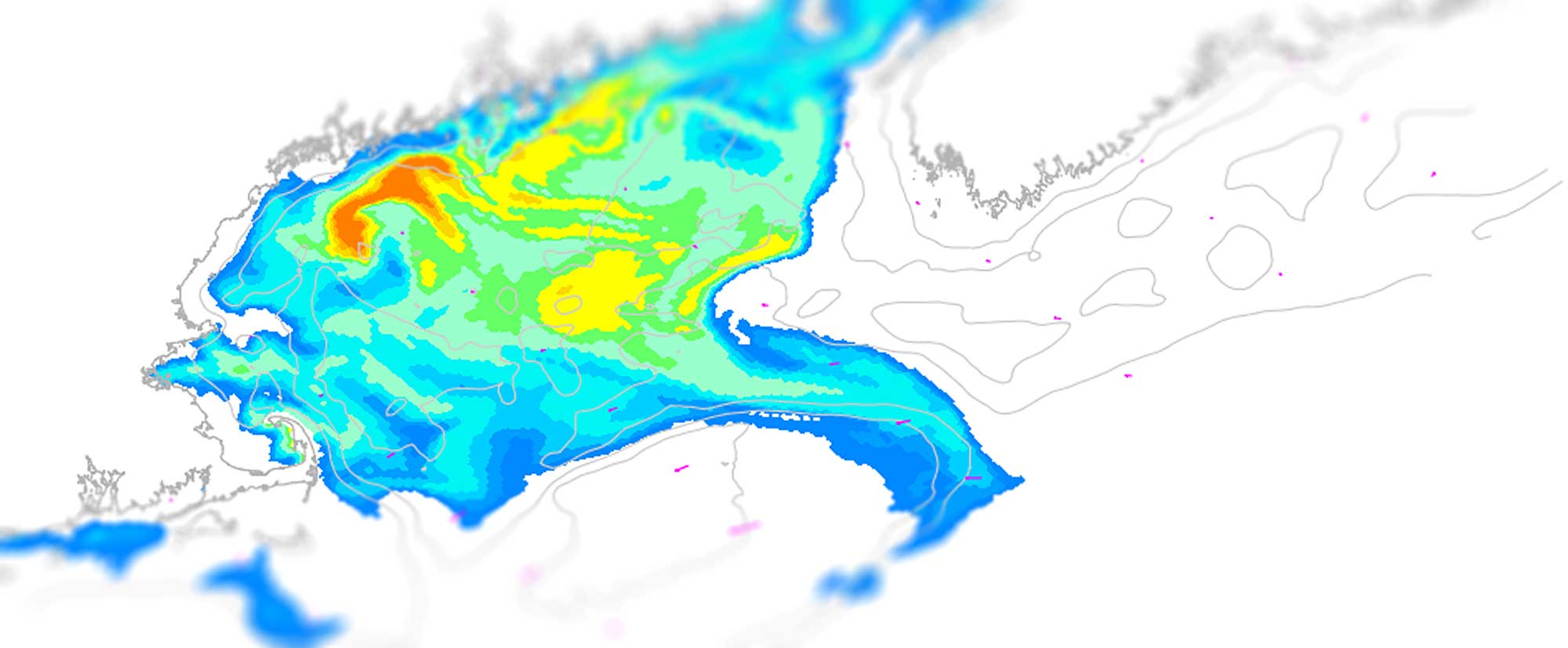The most well known harmful algal bloom (HAB) on the east coast is Alexandrium catenella, also known as the Gulf of Maine “red tide.” This toxic dinoflagellate produces saxitoxins that can accumulate in shellfish and cause paralytic shellfish poisoning in human consumers. It occurs from Maine to New York.
Other HABs that create issues in the region include Margalefidinium, Alexandrium monilatum, Aureococcus anophagefferens, and Karlodinium. These HABs kill fish and shellfish, impacting both aquaculture and wild stocks. Most also cause high biomass blooms that discolor the water brown or red. Dinophysis, which produces, diarrhetic shellfish poisoning toxins, has caused problems in several states. A variety of other HABs can also occur in this region.
NOAA Resources
Harmful Algal Bloom Monitoring System
NOAA's National Centers for Coastal Ocean Science developed this site to routinely deliver near real-time products for use in locating, monitoring, and quantifying algal blooms in coastal and lake regions of the U.S. This application delivers a suite of bloom detection products in the form of geographic based images.
Improving the Gulf of Maine HAB Forecast with Environmental Sample Processors
Toxic algal blooms pose a serious health risk and often disrupt valuable regional shellfisheries. Eating seafood tainted with algal toxins can sicken or even kill people. NOAA is pioneering use of the Environmental Sample Processor (ESP) to make ocean observations that serve state and industry management needs. ESPs robotically detect algal cells and toxin at sea and warn managers when levels rise. ESP data can also be assimilated into numerical models to improve the accuracy of bloom forecasts.
Experimental Gulf of Maine Alexandrium catenella Nowcast/Forecast Simulation
Models initiated from a cyst abundance map from October 2018, with germination, growth, and transport of Alexandrium catenella cells in the Gulf of Maine.
NOAA is announcing $18.9 million in funding for harmful algal bloom (HAB) research projects and monitoring activities throughout U.S. coastal and Great Lakes waters.
Chesapeake, Delaware Bay, Long Island Sound Resources
The Chesapeake and Delaware Bays are subject to a variety of HABs that can kill fish and shellfish. While they do not threaten human health, they can have severe impacts on fisheries and aquaculture. New funding will support research in Delaware Bay investigating the role of nitric oxide in promoting blooms of Heterosigma. In the lower Chesapeake Bay, a new study to better predict Margalefidinium and Alexandrium monilatum blooms, and a continuing project on the toxicity and food web impacts of A. monilatum will help the shellfish industry minimize their impacts. A study of a naturally occurring compound that may control some toxic HABs will continue to test its effectiveness and environmental impacts.
Chesapeake Bay & Coastal Bays Monitoring
The Maryland phytoplankton monitoring program evaluates the algal community at 34 Chesapeake and 13 Coastal Bays stations monthly (April – Nov).
Harmful Algal Blooms in Maryland
HAB resources and links from Marylands's Department of Natural Resources.
State of Maryland Eyes on the Bay Harmful Algal Blooms
Cell counts of HABs in Maryland.
Harmful Algal Blooms in Lower York & Lower James Rivers and Chesapeake Bay
HAB frequently asked questions and links from Virginia's Department of Health.
State of Virginia Algal Bloom Surveillance Map
Cell counts of HABs in Virginia.
Long Island Sound: Harmful Algal Blooms and Marine Biotoxins
HAB frequently asked questions, links, and resources from New York's Department of Environmental Conservation.
Stonybrook University Real time Water Quality Data
In situ (on site) sensors on moorings provide real-time data on chlorophyll and phycocyanin relative fluorescence for Long Island Sound, New York.
New England/Gulf of Maine Resources
Along the New England coast blooms of Alexandrium produce neurotoxins that can accumulate in shellfish, causing paralytic shellfish poisoning in human consumers. To protect human health, sections of the coast must be closed to shellfish harvesting. New research will investigate how microscopic animals control the growth and toxicity of Alexandrium. Continuing research will use remote toxin sensors to determine how shellfish in the eastern Gulf of Maine become toxic. The information from both studies will be incorporated into predictive models that forecast when and where Alexandrium blooms will occur in the Gulf of Maine, helping state managers and the shellfish industry protect public health and minimize economic disruption.
New England Harmful Algal Bloom / Red Tide Information
Maine’s Department of Marine Resources Public Health Bureau monitors several biotoxins produced by different types of marine algae known as phytoplankton.
Biotoxins in Maine
Maine’s Department of Marine Resources Public Health Bureau monitors several biotoxins produced by different types of marine algae known as phytoplankton.
Massachusetts Shellfish Sanitation Program
Learn about how shellfish are managed in Massachusetts from the Department of Marine Fisheries.
 An official website of the United States government.
An official website of the United States government.


Social